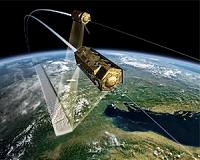 |
Pasadena CA (SPX) Jun 11, 2010 NASA Deputy Administrator Lori Garver and German Aerospace Center (DLR) Executive Board Chairman Johann-Dietrich Worner signed an agreement Thursday during a bilateral meeting in Berlin to extend the Gravity Recovery and Climate Experiment (Grace) mission through the end of its on-orbit life, which is expected in 2015. Launched in March 2002, Grace tracks changes in Earth's gravity field by noting minute changes in gravitational pull from local changes in Earth's mass. It does this by measuring changes in the distance between its two identical spacecraft to one-hundredth the width of a human hair. These spacecraft, developed by NASA's Jet Propulsion Laboratory, Pasadena, Calif., are in the same orbit approximately 220 kilometers (137 miles) apart. "The extension of this successful cooperative mission demonstrates the strength of the NASA-DLR partnership and our commitment to continue working together in this very important area of Earth science," Garver said. NASA and DLR signed the original agreement in 1998. The two agencies jointly developed the Grace mission and have cooperated on its operational phase since its launch. For the twin satellite mission, NASA provided the instruments and selected satellite components, plus data validation and archiving. DLR provided the primary satellite components, launch services and operations. Grace maps gravity-field variations from month to month, recording changes caused by the seasons, weather patterns and short-term climate change. "The extension of this successful mission will deliver more valuable data to help us understand how Earth's mass and gravity varies over time," Worner said. "This is an important component necessary to study changes in global sea level, polar ice mass, deep ocean currents and depletion and recharge of continental aquifers. We appreciate the strong cooperation with our partner NASA." Grace's monthly maps are up to 100 times more accurate than existing maps, substantially improving the accuracy of techniques used by oceanographers, hydrologists, glaciologists, geologists and climate scientists. Data from the Grace mission have been used to measure the amount of water lost in recent years from the aquifers for California's primary agricultural region in the state's Central Valley. An international study recently used Grace data to show that ice losses from Greenland's ice sheet now are rapidly spreading up its northwest coast.
Share This Article With Planet Earth
Related Links Grace mission Earth Observation News - Suppiliers, Technology and Application
 Integration Of TanDEM-X With Launcher Begins
Integration Of TanDEM-X With Launcher BeginsBonn, Germany (SPX) Jun 11, 2010 I have now settled myself in Baikonur and become acquainted with everyday issues. As of last Tuesday, I have replaced my colleague Michael Bartusch as the project management representative of the space agency here at the launch site. I will be reporting about the TanDEM-X satellite (TDX) on this blog up until the launch. Preparations for the launch during the last few weeks have gone ... read more |
|
| The content herein, unless otherwise known to be public domain, are Copyright 1995-2010 - SpaceDaily. AFP and UPI Wire Stories are copyright Agence France-Presse and United Press International. ESA Portal Reports are copyright European Space Agency. All NASA sourced material is public domain. Additional copyrights may apply in whole or part to other bona fide parties. Advertising does not imply endorsement,agreement or approval of any opinions, statements or information provided by SpaceDaily on any Web page published or hosted by SpaceDaily. Privacy Statement |